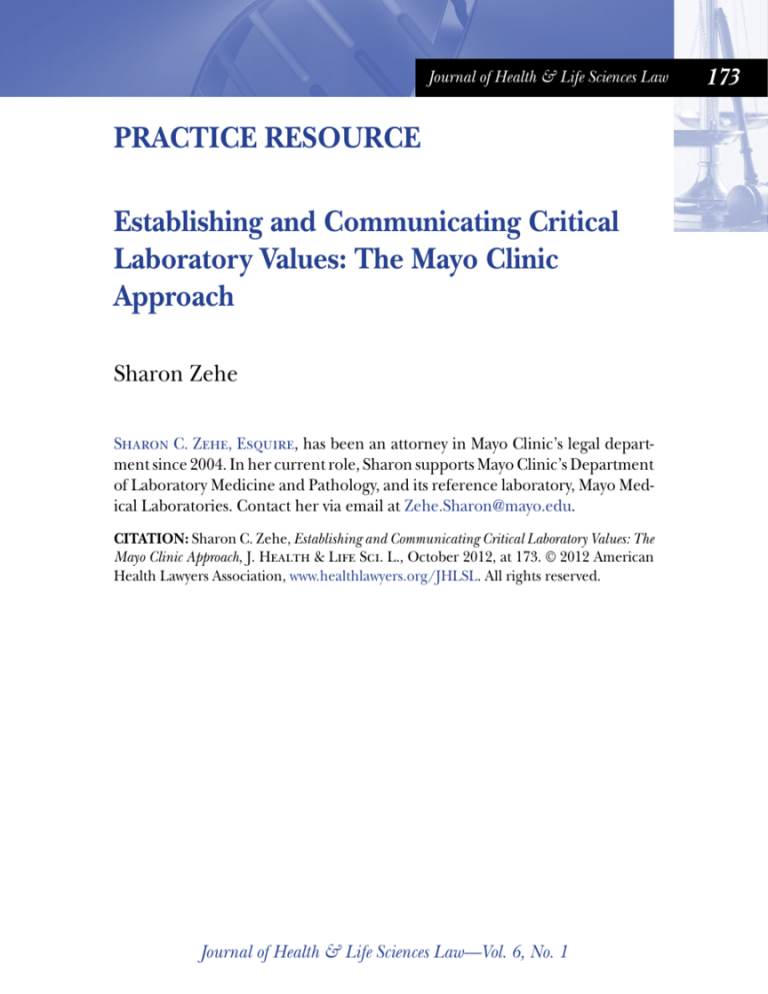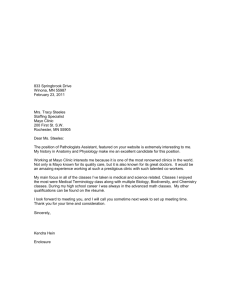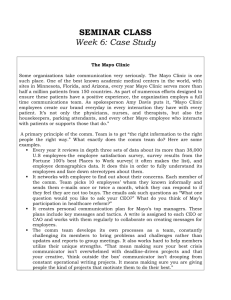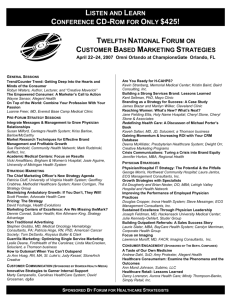
Journal of Health & Life Sciences Law
PRACTICE RESOURCE
Establishing and Communicating Critical
Laboratory Values: The Mayo Clinic
Approach
Sharon Zehe
Sharon C. Zehe, Esquire, has been an attorney in Mayo Clinic’s legal department since 2004. In her current role, Sharon supports Mayo Clinic’s Department
of Laboratory Medicine and Pathology, and its reference laboratory, Mayo Medical Laboratories. Contact her via email at Zehe.Sharon@mayo.edu.
CITATION: Sharon C. Zehe, Establishing and Communicating Critical Laboratory Values: The
Mayo Clinic Approach, J. Health & Life Sci. L., October 2012, at 173. © 2012 American
Health Lawyers Association, www.healthlawyers.org/JHLSL. All rights reserved.
Journal of Health & Life Sciences Law—Vol. 6, No. 1
173
174
Zehe: Critical Laboratory Values
Zehe: Critical Laboratory Values
CONTENTS
Introduction........................................................................................... 175
Licensing and Accreditation Requirements......................................... 176
Clinical Laboratory Improvements Amendments of 1988............. 176
Joint Commission National Patient Safety Goals............................ 176
College of American Pathologists.................................................... 178
Practical Meaning of Critical Results.................................................... 181
Duty to Act/Standard of Care............................................................... 182
Mayo Clinic’s Critical Results/Semi-Urgent Results Program............ 184
Time between collection and testing............................................... 185
Mayo Clinic’s notification process................................................... 186
Non-patient results............................................................................ 187
Who Should Receive Results?............................................................... 188
CLIA/HIPAA–current state.............................................................. 189
CLIA/HIPAA–proposed regulations............................................... 190
Table 1: Existing Laws in States/Territories Pertaining to
Test Reports.................................................................................... 191
Mitigating the Risks............................................................................... 192
Mayo Clinic patient portal................................................................ 193
Mayo’s decision................................................................................. 194
Conclusion............................................................................................. 195
Journal of Health & Life Sciences Law—Vol. 6, No. 1
Introduction
175
Introduction
As science and healthcare continue to expand and evolve, so does
laboratory testing. Many individuals may think of laboratory tests as
only diagnosing disease. They may not realize laboratory tests also can
assess risk that an individual may develop a disease (e.g., Huntington’s
disease), or assist in properly dosing medications (e.g., warfarin).
Mayo Clinic’s laboratory, the Department of Laboratory Medicine
and Pathology, has a test menu exceeding 3,000 different assays. Its test
menu continually evolves as researchers, scientists, and clinicians work
together to connect laboratory values to patient health and struggle
with the following questions or situations:
• What is the value of all that information?
• What happens when a healthcare provider does not act on a
test result with critical information about a patient’s health that
could require immediate medical intervention?
• Would the impact be lessened if a patient has direct access to
his or her laboratory results?
• Would direct access help get critical information to the patient,
or instead, would it confuse a patient or cause unnecessary
worry about the results’ meaning?
This Practice Resource surveys the landscape of legal and practical
risks pertaining to laboratory results, beginning with an overview of
what regulations apply and what accreditation requirements exist in
the section entitled, Licensing and Accreditation Requirements. An
exploration of the Practical Meaning of Results follows, including a
discussion of the Standard of Care. This Practice Resource will provide direction on identifying best practices. One possible solution for
communicating laboratory results is set forth in a detailed description
of the Mayo Clinic’s Critical Results/Semi-Urgent Results Program. As
this discussion will demonstrate, many times the answer does not lie
within the law—it lies within what is best for patient care.
Journal of Health & Life Sciences Law—Vol. 6, No. 1
176
Zehe: Critical Laboratory Values
Licensing and Accreditation Requirements
As outlined further below, the federal regulations offer basic direction in defining the expectations surrounding critical results. In
addition, direction can be found in accreditation requirements and
guidelines. However, these do not offer a clear picture of compliance
for laboratories, leaving healthcare organizations to their own discretion and interpretation.
Clinical Laboratory Improvements Amendments of 1988
All laboratories performing human diagnostic testing are required
to comply with federal regulations known as the Clinical Laboratory
Improvements Amendments of 1988 (CLIA).1 These regulations set
the minimum level of requirements for laboratory quality and consistency to ensure patient safety.
Under the CLIA regulations, laboratories must “. . . immediately
alert the individual or entity requesting the test and, if applicable, the
individual responsible for using the test results when any test result
indicates an imminently life-threatening condition, or panic or alert
values.”2 Although this requirement sets a minimum standard, it provides only some guidance to laboratories on critical results and touches
only the tip of the issue. It does not define what tests are considered
“life-threatening.” It does not define what time frame is acceptable
except to say “immediately.” Finally, it does not specify who “the individual” may be for purposes of notification.
Joint Commission National Patient Safety Goals
The CLIA regulations set the minimum standards for laboratory
quality. In addition, each laboratory must comply with requirements
set by different accrediting organizations. The Centers for Medicare
1
2
42 C.F.R. § 493.
42 C.F.R. § 493.1291(g).
Journal of Health & Life Sciences Law—Vol. 6, No. 1
Licensing and Accreditation Requirements
177
& Medicaid Services (CMS) chooses which accrediting organizations
have the authority to inspect and accredit laboratories. Some examples
of the most common laboratory accrediting organizations include The
Joint Commission (TJC), the College of American Pathologists (CAP),
and state health departments.
TJC and CAP have tried to address the challenges for laboratories and healthcare providers in effectively using critical results. As a
starting point, TJC set one of its 2012 National Patient Safety Goals
(NPSG) as, “Report critical results of tests and diagnostic procedures
on a timely basis.”3 Although it does not offer additional guidance on
what specific tests are considered critical, TJC provides a slightly different overall definition from the CLIA regulations in its rationale
for the patient safety goal: “Critical results of tests and diagnostic procedures fall significantly outside the normal range and may indicate
a life-threatening situation.” The rationale is further clarified: “The
objective is to provide the responsible licensed caregiver these results
within an established time frame so that the patient can be promptly
treated.”4
Rather than “immediate” notification as used in CLIA, TJC only
states that notification be “timely.” Rather than list specific requirements, TJC states the goal for patient safety. This implies that the time
frame for notification of potential life-saving test results can be any
time that would allow proper patient treatment. This allows healthcare providers and laboratories discretion to establish the appropriate
time frame. Although such discretion can be beneficial in that it allows
a care provider to understand a patient’s condition, it also can work
against laboratories attempting to establish effective notification processes for varying levels of patient conditions.
3
4
The Joint Commission, National Patient Safety Goals Effective January 1, 2012: Laboratory
Accreditation Program; NPSG.02.03.1 (Jan. 1, 2012), available at www.jointcommission.
org/assets/1/6/NPSG_Chapter_Jan2012_LAB.pdf.
Id.
Journal of Health & Life Sciences Law—Vol. 6, No. 1
178
Zehe: Critical Laboratory Values
In NPSG’s Elements of Performance, TJC offers additional guidance to laboratories and healthcare providers about what an effective
critical results notification program may include:5
• Collaborate with organization leaders to develop written procedures for managing the critical results of tests and diagnostic
procedures that address the following:
• The definition of critical results of tests and diagnostic
procedures
• By whom and to whom critical results [] are reported
• The acceptable length of time between the availability and
reporting of critical results [].
• Implement the procedures for managing the critical results [].
• Evaluate the timeliness of reporting the critical results [].
Even though this may seem a natural process for healthcare providers
wishing to establish an appropriate critical test result policy and procedure, oftentimes it is difficult for experts to agree on all the nuances of
test results and health conditions, reporting procedures, and follow-up
activities. An explanation of how Mayo Clinic has created its program
encompassing the factors above will be outlined later in this Practice
Resource.
College of American Pathologists
CAP, the leading organization of board-certified pathologists dedicated to quality in pathology and laboratory medicine, publishes
checklists each year to measure laboratories’ quality systems. The
checklists are available to CAP member laboratories to assist in ensur5
Id.
Journal of Health & Life Sciences Law—Vol. 6, No. 1
Licensing and Accreditation Requirements
179
ing compliance. Currently, there are two checklist items, Critical Result
Notification and Critical Result Read-Back, relative to critical results in
the CAP All Common Checklist. The Critical Result Notification6 states:
The laboratory has procedures for immediate notification
of a physician (or other clinical personnel responsible for
the patient’s care) when results of designated tests exceed
established “alert” or “critical” values that are important
for prompt patient management decisions.
NOTE: Alert or critical results are those results that may require
rapid clinical attention to avert significant patient morbidity or
mortality. The laboratory may establish different critical results
for specific patient subpopulations (for example, dialysis clinic
patients). Critical results should be defined by the laboratory
director, in consultation with the clinicians served.
Allowing clinicians to “opt out” of receiving critical results is
strongly discouraged.
Records must be maintained showing prompt notification of the
appropriate clinical individual after obtaining results in the
critical range. These records should include: date, time, responsible laboratory individual, person notified (the person’s first
name alone is not adequate documentation), and test results.
Any problem encountered in accomplishing this task should be
investigated to prevent recurrence.
Reference laboratories may report critical results directly to clinical
personnel, or to the referring laboratory. The reference laboratory
should have a written agreement with the referring laboratory that
indicates to whom the reference laboratory reports critical results.
6
COM.30000 Critical Results Notification (2011).
Journal of Health & Life Sciences Law—Vol. 6, No. 1
180
Zehe: Critical Laboratory Values
Second, the Critical Result Read-Back7 states:
When critical results are communicated verbally or by
phone, there is a policy that laboratory personnel ask for
a verification “read-back” of the results.
NOTE: Laboratory personnel should document the read-back.
Transmission of critical results by electronic means (FAX or computer) is acceptable. If critical results are transmitted electronically,
the laboratory should confirm receipt of the result by the intended
recipient (e.g., by a phone call); however, no read-back is necessary.
Similar to TJC, CAP does not define what tests are considered critical, nor does it provide a reporting timeline other than “immediate
notification” when the results exceed an alert or critical value.
How should an organization determine how to comply when the
regulations are not clear and accreditation requirements do not add
significant clarification? Thankfully, discretion works to the organization’s benefit, as the answer may vary depending on many factors
discussed in the following sections.
Asking clinicians
The practical answer involves working with clinicians—the individuals who use the results in treating patients. Although this may seem
easy, challenges will arise as patients have different needs. Clinicians
may not always agree on what tests are important and what value would
trigger a concern for their patients.
Benchmarking
Another way an organization can determine best practices for critical values is to benchmark with other organizations and accrediting
agencies, e.g., certain tests, such as a glucose level, always will be on a
critical value list when a value is significantly outside the range; however, other tests may not be so obvious.
7COM.30100 Critical Results Read-Back (2011).
Journal of Health & Life Sciences Law—Vol. 6, No. 1
Practical Meaning of Critical Results
181
Patient demographics
Another consideration for setting critical values is reviewing patient
demographics. If a hospital is in a rural setting where outpatients are
not easily brought back into the hospital for urgent needs, organizations should consider setting a value that is not as critical as that of
a hospital where demographics indicate less travel time is needed.
Additionally, specialty care centers that work with patients already
diagnosed with a condition, such as renal failure, may have different
critical values because an abnormal result is expected in their patients.
Practical Meaning of Critical Results
Although many laboratories have similar lists of critical tests and
values,8 setting critical values that will have meaning to all care providers is not possible. For example, when a patient is being treated for a
disease, a critical result may be expected. Therefore, the critical value
is not abnormal. Calling the physician with the critical value does not
add value to the patient’s care because the physician is already aware
of the condition and treating the patient appropriately.
Similarly, many results can be critical to a particular patient but otherwise would not be considered outside the normal range. For example,
hemoglobin tests generally are not considered a critical value. For a
trauma victim, however, a sharp drop in a hemoglobin value may signal
internal bleeding and becomes critical to that patient. In a one-sizefits-all approach, neither the result nor the significant drop would be
called to the physician.
Even the point at which a value may be critical can differ depending
on patient demographics. The point may be different for a hospital
inpatient where the physician or other individual provider only has
to walk down the hall for follow-up than it is for a rural patient, where
8
See Anne Paxton, Same Book, Different Page–Handling Critical Values, CAP Today Dec. 2006.
Journal of Health & Life Sciences Law—Vol. 6, No. 1
182
Zehe: Critical Laboratory Values
the responsible provider has to locate the patient and ask him or her
to return to the hospital or clinic. The critical threshold for a rural
patient’s value may occur sooner than for the inpatient.
Finally, most healthcare providers do not have pathology or radiology results on a critical value notification list. This seems unusual as
many life-threatening conditions are diagnosed using such images or
slides. Is the difference that these images require a specialist individual
provider to interpret the image or slide and do not fit easily into an
electronic solution? Is it the specialists’ expectation to call the treating
providers when he or she sees something critical?
As these practical challenges with setting and critical values illustrate, it is difficult for any healthcare provider or laboratory to design
a policy that will address them adequately. Laboratory information systems and electronic medical records are not able to distinguish patient
demographics when alerting physicians to critical values. If every situation and patient scenario were mapped out to address the potential for
a critical situation, the list of critical values would be endless.
Duty to Act/Standard of Care
What is the care provider’s obligation to act when a critical value
result is received? That answer can vary a great deal depending on the
patient, the test, and the possibility of harm resulting from a failure to
act. Medical negligence arises when a provider owes a patient a duty,
the provider breaches that duty, and harm to a patient arises as a direct
result of that breach, resulting in damages. The provider’s duty of care
can be defined from a variety of sources, including how other providers respond in similar circumstances, how the provider’s policies and
procedures define expected behavior, and how the law or courts have
defined expected behavior.
In the laboratory setting, like in many medical malpractice cases,
a care provider’s obligations are not clear because laboratory results
offer only a limited view of a patient’s health condition. For example,
Journal of Health & Life Sciences Law—Vol. 6, No. 1
Duty to Act/Standard of Care
183
in Santos v. IL KIM, et al., a plaintiff sued a health system’s laboratory for
failing to notify her obstetrician of her Rh titer negative results, resulting in the brain injury and death of her child.9 In Ms. Santos’ case,
Rh negative results were critical in the care of her fetus. An Rh titer
assay is not normally listed on a laboratory’s critical results list, however. What made this plaintiff’s Rh negative results critical was the
impact to her fetus. The absence of an Rh titer assay on the health
system’s critical results list did not defeat her claim, because the standard of care was more important to the court than an abstract list of
tests. What would be a noncritical test for most non-pregnant women
became a critical result for this patient because of the potential impact
to her baby.
Thus, the standard of care in the Santos case was not defined by the
health system’s critical values list. Rather, it was defined by two experts
who testified via affidavit that “any lab running serial Rh titers for an
obstetrician should have in place procedural guidelines to insure that
such information gets to the physician in an appropriate manner.”10
The second expert went so far as to say the laboratory “. . . failed to
meet the proper standard of good laboratory practices placing [the
plaintiff’s] fetus at greater risk of death. . . .”11
The Santos case, however, does not render the critical values list
meaningless to a laboratory. Instead, it demonstrates that many laboratory results may not fit into the definition of critical value, yet still
can be critical to a particular patient. All healthcare providers should
understand that a critical results program is only the starting point
in patient care; it should never replace the individual healthcare provider’s expertise and attention.
This case also demonstrates that care providers need to review their
programs to understand their commitments to their patients. If an
9 Santos v. Kim, 706 N.E.2d 658 (Mass. 1999).
10 Id. at 663.
11 Id.
Journal of Health & Life Sciences Law—Vol. 6, No. 1
184
Zehe: Critical Laboratory Values
organization defines which tests are critical and need immediate attention, it should develop a program to ensure notification. If a result
is not communicated to the care provider according to a healthcare
organization’s policies and procedures and the patient is harmed as
a result of the failure to notify his or her care provider, the evidence
already weighs in favor of the patient.
Mayo Clinic’s Critical Results/Semi-Urgent Results
Program
To assist organizations in addressing these issues, it may be helpful to review what Mayo Clinic has established in its programs to help
respond to these challenges. Although Mayo Clinic has established
what it considers a gold standard approach to notifying individual
healthcare providers of critical values or semi-urgent values (explained
in detail below), the reality is that the Mayo Clinic physicians, specialists, and laboratory directors understand that critical value and
semi-urgent value policies and procedures do not replace the direct
care providers’ expertise.
Healthcare providers reviewing Mayo Clinic’s program also should
consider the unique patient population at Mayo. Many patients travel
to Mayo Clinic because they have been diagnosed with a rare or difficult disease. Mayo has taken these challenges into consideration as
it sets its critical values. Therefore, although Mayo Clinic’s program is
robust and created with the best patient care outcomes in mind, the
approach may not fit all provider settings.
Mayo Clinic has developed a two-tiered approach to critical and
semi-urgent values. The intent behind this two-tiered system was to
identify laboratory results needing immediate attention for patient
care, yet also fit into an electronic solution that would allow an easy
flow of information. While pathology and radiology remain important diagnostic tools, they have not been included yet in the formal
programs.
Journal of Health & Life Sciences Law—Vol. 6, No. 1
Mayo Clinic’s Critical Results/Semi-Urgent Results Program
185
Mayo Clinic defines a critical result as “a value that represents a pathophysiological state at such variance with normal (expected values) as to
be life-threatening unless something is done promptly and for which
some corrective action could be taken.”12 This definition is yet another
variation of the regulatory definitions shared above, but captures what
the care teams believe is the essence of these values’ importance.
A semi-urgent result is one that does not pose the same immediate
health threat as would a critical value, but has near-term severe consequences if not acknowledged and/or treated. Mayo Clinic created
this definition to address the concern that many tests results were not
getting necessary attention because they were not significant enough
to qualify as critical, yet warranted more timely attention than other
laboratory results.
An established team of laboratorians, clinicians, and regulatory
advisors reviews the critical and semi-urgent tests at least annually.
Using medical and scientific expertise, the group reviews existing tests
to determine whether they should remain on the list and whether each
test’s value has changed.
Once the team reviews and approves the list of tests and values,
the list goes through a rigorous approval process. To ensure a variety
of experts in laboratory testing and patient care select key results, set
critical values in various settings, and provide methodologies for timely
reporting from the laboratory, three formal committees within Mayo
Clinic review and approve the list before implementation.
Time between collection and testing
An area that typically receives little attention in the healthcare setting
is the time between the specimen’s collection and the time the laboratory
knows the result. Although the federal regulations focus on the time in
12 Critical Values/Critical Results List Summary (CL 041647.004), DLMP Critical Values / Critical
Results List (eff. Oct. 25, 2011), available at www.mayomedicallaboratories.com/articles/
criticalvalues/view.php?name=Critical+Values%2FCritical+Results+List.
Journal of Health & Life Sciences Law—Vol. 6, No. 1
186
Zehe: Critical Laboratory Values
which an individual provider should receive a critical result notification,
no regulations address the time between the collection and the test.
A CAP study released in 2007 showed critical test results were communicated to individual providers a median of four minutes after the
result was known in the laboratory.13 However, the results actually were
called 56 minutes after the specimen was collected.14 Considering the
time the patient may have had the condition or symptoms, seeking
treatment changes the picture even more.
At Mayo Clinic, for example, every effort is undertaken to reduce
the time between collections and testing. The campus contains several
draw stations for patient convenience, and multiple testing locations.
All specimens are tracked from the time of the draw through the
point of results, allowing an analysis of where time is most spent. If
laboratory staff or clinicians identify issues, Mayo Clinic uses process
engineers to review where time is spent and whether efficiencies can
be implemented or wasted time reduced. In addition, most laboratories function around the clock to ensure there is no delay in getting a
critical result to an individual provider.
Although most organizations do not have such an elaborate tracking
system or engineering department, these concepts can be incorporated into most organizations. Many quality healthcare systems’ tools
can be used to identify waste and create efficiencies.
Mayo Clinic’s notification process
Mayo Clinic uses an internal call center approach to notify ordering providers of critical results. The call center, known as the Mayo
Lab Inquiry (MLI), handles calls to both internal Mayo providers and
13CAP, Critical Values: Physician Notification Processes (Dec. 2007).
14 Anne Paxton, Good News on Critical Values, Says Q-Probes Audit, CAP TODAY, Feb. 2008,
available at www.cap.org/apps/cap.portal?_nfpb=true&cntvwrPtlt_actionOverride
=%2Fportlets%2FcontentViewer%2Fshow&_windowLabel=cntvwrPtlt&cntvwrPtl
t{actionForm.contentReference}=cap_today%2Ffeature_stories%2F0208_Qprobe.
html&_state=maximized&_pageLabel=cntvwr.
Journal of Health & Life Sciences Law—Vol. 6, No. 1
Mayo Clinic’s Critical Results/Semi-Urgent Results Program
187
external clients for Mayo Medical Laboratories (MML). The process
followed by MLI includes a process as outlined in the CAP checklist
identified earlier.
First, Mayo Clinic’s laboratory reporting software sends a notice to
an MLI client services representative, who is expected to begin calling
the ordering provider as soon as possible, with an expectation that the
provider receives results in no less than sixty minutes from the time the
critical value is available. In addition, the laboratory reporting software
sends the results through to the patient’s medical record, or in the case
of MML clients, through the interface to the ordering hospital or via
fax for non-interfaced clients. Second, once a responsible care provider
is reached, the physician or responsible designee is required to readback the patient name, the patient’s clinic number or other unique
identifier, and the critical test result. This ensures the information has
been communicated accurately. Finally, once the result is relayed, the
communication is documented in the laboratory’s tracking system in
the event a question arises regarding the timing of communication.
Non-patient results
What happens when the care providers are not part of the same
health system as the laboratory? Although it may seem easy for a
provider the size of Mayo Clinic to have multiple draw stations and
multiple laboratories, Mayo also operates MML, a for-profit subsidiary
providing reference testing to more than 4,000 hospitals, clinics, and
laboratories serving customers in more than 130 countries. Reporting
critical results presents additional challenges when the care provider
is across the country or across the globe, including language barriers,
time zone differences, or even lack of provider information.
To address many of these challenges, MML uses the same process
Mayo Clinic has established for its patients—to get the results to the
provider within sixty minutes. This may be difficult when the care provider is half-across the world, or the ordering provider is listed only
Journal of Health & Life Sciences Law—Vol. 6, No. 1
188
Zehe: Critical Laboratory Values
with a facility name. Therefore, in addition to calling the healthcare
provider, MML also faxes or sends results electronically via a secure
interface to the provider. Although not meant to replace a direct notification of the result, many times following the normal process for
releasing results can get the result to the right provider sooner.
Who Should Receive Results?
A topic of debate is who should receive the critical results from the
laboratories. The CLIA regulations state the individual or entity requesting the test should receive the call. The CAP accreditation checklist
states it should be a physician or other clinical personnel responsible
for the patient’s care. TJC states it should be the responsible licensed
caregiver. All of these seem relatively straightforward but in practice
can be complicated by normal activities such as shift changes and the
fast-paced energy of an emergency room.
As an example, in large hospital settings or in academic medical
centers, many caregivers are assigned to one patient. The medical resident may be the provider ordering the test, but the result may be called
to the supervising physician instead of the resident. The supervising
physician may not immediately understand the situation or may need
to discuss the patient’s current state before acting on the result. In
another scenario, who should be responsible to receive critical results
that a physician in the emergency room ordered and whose shift is
now over? It is important to identify those responsible to receive those
results to ensure continuity of care.
Smaller practice settings pose different questions for consideration.
Who should receive results when there may be only one or two physicians? Can a clinical assistant receive those results to pass along to
the physician when he or she is again available? Is there harm in communicating a critical result to a person who is not a trained, licensed
provider?
Journal of Health & Life Sciences Law—Vol. 6, No. 1
Who Should Receive Results?
189
Healthcare providers need to review these challenges with the goal
to relay test results to someone who can act on them to ensure the
patient gets the necessary treatment. Although these questions cannot
be answered with a one-size-fits-all approach, the answer always should
be to get the results to an individual provider who has the knowledge
to understand the results’ importance and the authority and understanding to take immediate action.
The Mayo Clinic has limited the types of individuals appropriate to
receive critical results. It has defined a provider as physicians, nurses,
physician assistants, and nurse practitioners. It does not view clinical
assistants, medical secretaries, or administrative assistants as appropriate individuals to receive critical results, as these individuals may not
understand the impact of the critical value on the patient’s well-being.
CLIA/HIPAA—current state
Many laboratories face an issue of what to do when patients call and
want access to their laboratory results. Although it may seem obvious
that patients are entitled to their health information in light of the
Health Insurance Portability and Accountability Act of 1996 (HIPAA),
laboratories should understand they function differently from their
healthcare provider counterparts. “Test results must be released only
to authorized persons and, if applicable, the individual responsible for
using the test results and the laboratory that initially requested the
test.”15 CLIA also defines an authorized individual as “. . . an individual authorized under State law to order tests or receive test results,
or both.”16 If a state does not provide individual access for patients
to receive their results, patients can receive their results only through
their care providers. Table 1, Existing Laws in States/Territories Pertaining to Test Reports, outlines which states allow patients to receive
results directly.
15 42 C.F.R. § 493.1291(f ).
16 Id. § 493.2.
Journal of Health & Life Sciences Law—Vol. 6, No. 1
190
Zehe: Critical Laboratory Values
HIPAA includes a specific exemption from the patient access to
information requirement for CLIA-licensed laboratories:
(a) Standard: Access to protected health information.
(1) Right of access. Except as otherwise provided in paragraph
(a)(2) or (a)(3) of this section, an individual has a right of
access to inspect and obtain a copy of protected health information about the individual in a designated record set, for as long
as the protected health information is maintained in the designated record set, except for:
. . . (iii) Protected health information maintained by a covered
entity that is:
(A) Subject to the Clinical Laboratory Improvements Amendments of 1988, 42 U.S.C. 263a,
to the extent the provision of access to the
individual would be prohibited by law; or
(B) Exempt from the Clinical Laboratory
Improvements Amendments of 1988,
pursuant to 42 CFR 493.3(a)(2).17
CLIA/HIPAA—proposed regulations
In September 2011, CMS issued the Proposed Rule to amend both
CLIA regulations and HIPAA regulations to allow patients to access
their results directly from the laboratory.18 Under these proposed regulations, CLIA would be amended to allow the laboratory to release
the results, provided it could verify through its authentication process
that the results belonged to the requesting patient. HIPAA would be
amended to remove 45 C.F.R. § 164.524(a)(1)(iii)(A) and (B). Laboratories that are also covered entities would have the same obligations
17 45 C.F.R. §§ 164.524(a)(i)–(iii).
18 CLIA Program and HIPAA Privacy Rule; Patients’ Access to Test Reports, 76 Fed. Reg.
56712–24 (proposed Sept. 14, 2011) (to be codified at 42 C.F.R. pt. 493 and 45 C.F.R.
pt. 164).
Journal of Health & Life Sciences Law—Vol. 6, No. 1
191
Who Should Receive Results?
Table 1. Existing Laws in States/Territories
Pertaining to Test Reports
HIPAA will preempt state law
Compatible with state law
Allows test reports
only to provider
Allows test reports
to patient with
provider approval
Allows test reports
to patient
No state law
Arkansas
California
Delaware
Alabama
Georgia
Connecticut
District of Columbia
Alaska
Hawaii
Florida
Maryland
Arizona
Illinois
Massachusetts
New Hampshire
Colorado
Kansas
Michigan
New Jersey
Guam
Maine
New York
Nevada
Idaho
Missouri
Virginia
Oregon
Indiana
Pennsylvania
Puerto Rico
Iowa
Rhode Island
West Virginia
Kentucky
Tennessee
Louisiana
Washington
Minnesota
Wisconsin
Mississippi
Wyoming
Montana
Nebraska
New Mexico
North Carolina
North Dakota
N. Mariana Islands
Ohio
Oklahoma
South Carolina
South Dakota
Texas
Utah
Vermont
Virgin Islands
Source: 76 Fed. Reg. 56712-56724, 56721 (Table 6) (Sept. 14, 2011)(proposed rule).
Journal of Health & Life Sciences Law—Vol. 6, No. 1
192
Zehe: Critical Laboratory Values
to provide patient access to protected health information as any other
healthcare provider under HIPAA. The changes to HIPAA would
preempt any state law with a restriction to the contrary under the
HIPAA preemption provision in 45 C.F.R. § 160.203. While the comment period closed in November of 2011, a final rule has not been
issued. CMS included a state-by-state impact in its Notice of Proposed
Rulemaking, included here as Table 1.
Underlying these proposed regulatory changes, there is much
debate about the value of allowing patients to access their results.
Although patient advocates see access as every patient’s right, others
see the potential for unnecessary concern when a patient does not
understand what a result means. A good example of such a risk involves
prenatal screening. Many pregnant women choose to have chromosome testing performed on their unborn fetuses to identify problems
early on in pregnancy. Seeing a normal chromosome test result may
give false comfort to the mother, even in light of an ultrasound result
showing a problem, as she may not understand a laboratory test is only
one piece of a complicated puzzle.
For other patients, a genetic mutation of unknown significance may
be identified. This may cause undue worry to a layperson, because he
or she will not necessarily understand genetic mutations may mean
nothing more than a difference that has not been understood yet by
science.
Mitigating the Risks
To prevent any confusion about what a result means, healthcare
providers may consider building in a delay before making laboratory
results available to patients. This delay allows the physician to communicate with the patient about the meaning of results, or ensure a
patient has support when receiving negative information. For example, when considering the incurable nature of Huntington’s disease,
the diagnostic test carries a significant impact to the patient. Physicians
Journal of Health & Life Sciences Law—Vol. 6, No. 1
Mitigating the Risks
193
must appreciate the significance of the message and ensure patients
are adequately supported on receiving results.
If a delay is not built in, an anxious patient may check his or her
results frequently while waiting for information. If a patient sees a
result before the physician, does that result in panic or concern on
the part of the patient? If the risk for needless anxiety or confusion is
high, a delay may allow the physician to thoroughly explain a result
prior to the patient seeing it. The physician can ease a patient’s mind
by providing treatment options or arranging appropriate counseling
for a patient who may be anxious about a diagnosis.
Will the system require physician approval prior to transferring
information to a portal? This process would allow sensitive results to
be held until communication to the patient is complete. Or, will the
system automatically push the results to the portal, with education to
the physician about when information will be available to the patient
in case early intervention is necessary? Will the physician get a notice
through his or her e-mail that results have been transmitted to ensure
the physician contacts the patient timely with diagnosis information or
treatment options?
Mayo Clinic Patient Portal
Despite these risks, Mayo Clinic made the decision to give patients
immediate access to laboratory results through its patient portal.
Through the portal, patients can access portions of their medical
records, refill prescriptions, review clinical notes, and make appointments with their healthcare providers. Patients are able to review their
laboratory results as soon as the laboratory releases them. The laboratory results system automatically pushes results into the patient portal
without intervention from the patient or the ordering provider.
Journal of Health & Life Sciences Law—Vol. 6, No. 1
194
Zehe: Critical Laboratory Values
The portal’s goal is to ensure timely access to patient health information and to provide third-party providers such as the Mayo Clinic
Health Manager an easy way to download the medical information.19
The process itself is simple: patients sign into a secure portal with
a username and password. Upon logging in, patients can choose the
time frame (up to 36 months) of results they wish to view. Each test is
listed by name, followed by testing date, the patient’s result, a historical
chart for previous results, a listing of the normal reference range, and
any comments made by the provider.
Mayo’s decision
When Mayo Clinic reviewed the risks of making laboratory results
available immediately, it recognized the risks of giving a patient a
result he or she may not immediately understand. However, as patient
empowerment becomes the norm in healthcare, the decision was made
that even though patients may worry about a result they do not understand, the value of patients having immediate access to their results
outweighed that worry. Patients can call if they are confused about a
result. They can transfer the result to a local care provider if they are
not actively being treated at Mayo. This allows flexibility and ease of
access to information—something that is invaluable in patient care.
The only exceptions to this general rule of immediate access include
radiology and pathology results, which were believed to require more
complex interpretation than general laboratory tests. While these
results are not available through the portal currently, Mayo is working
to allow review, but only after a patient’s physician is able to review
19 Mayo Clinic Health Manager is a free online application developed by Mayo Clinic and
Microsoft.
Journal of Health & Life Sciences Law—Vol. 6, No. 1
Conclusion
195
the results. Mayo’s portal team is building a 36-hour delay between
when results are posted to the patient’s medical record and when those
results are pushed to the patient portal. The philosophy behind the
delay was to give providers a chance to review results, discuss with the
specialist when necessary, and communicate meaning to the patient
prior to results being made available through the portal.
Conclusion
Laboratory results are an ever-evolving and significant part of patient
care. Watching new test development or the growth of genetic testing
and its implications has been an amazing growth experience. The law
still is trying to catch up not only to the practical issues, but also to
the ethical issues surrounding testing. While critical results are only a
piece of this big picture, they represent patients’ most emergent health
conditions. Through effective communication policies and practices,
healthcare providers can have ease of mind concerning their patients’
well being.
Journal of Health & Life Sciences Law—Vol. 6, No. 1







